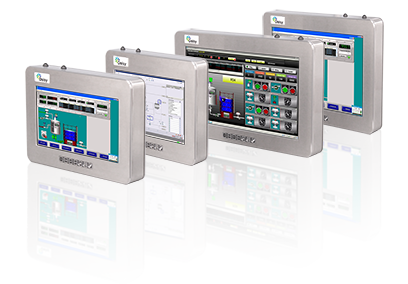Process Control Solutions Customized to Meet Your Industry 4.0 Needs
With the rise of Industry 4.0, establishing connections throughout factory infrastructure is vital to gaining real-time insights into operations. With PLC, thinclient, and edge computing and HMIs, you can connect your factory data to optimize production lines and increase efficiency. However, it can be challenging to find a provider that meets all of your hardware requirements.
As leaders in industrial computing technology, Daisy Data Displays helps clients from diverse backgrounds solve their biggest technical problems. Our PLC edge computing solutions are not only compatible with your existing software but also tailored to your needs. We offer fully customizable hardware designed to improve your production and achieve your most challenging goals.
HMIs for Real-Time Performance
Connecting the data from PLCs to an HMI provides an invaluable real-time look at your production equipment. By connecting your entire production line, you can stay informed on everything from bottlenecks to equipment maintenance needs to scrap levels and much more. At Daisy Data Displays, we develop custom solutions for clients whose hardware requirements are not met by their current provider.
We take a customer-centric approach to ensure you get the precise solution you need, delivered with minimal lead time. Our HMI products are available in formats greater than 15” for improved clarity and ease of use. They are developed to meet all classification environmental requirements. We also work with customer-supplied boards and offer full integration services and ongoing technical support.
Siemens
Our systems are compatible with Siemens WinCC (Windows Control Center). This HMI system offers efficient engineering tools designed to minimize plant downtime during modifications. As a high transparency system, it can help you optimize your production processes, reduce costs, and better avoid waste. Key features of WinCC include:
- Suitable for Standalone Applications: Create and manage your own monitoring systems, without being tied to SIMATIC software or hardware configurations.
- Flexible Integration: Many third-party devices are supported, enabling full customization according to your specific needs.
- Communication Protocols: WinCC accommodates multiple communication protocols, making it compatible with many hardware platforms.
- Project Management: Manage projects independently, without having to rely on SIMATIC Manager. Configure user access, create visualizations, manage alarms, and more.
Rockwell Automation
Running FactoryTalk requires a hardware system with 4 GB of memory and a 4-core processor, at minimum. OptiPanel units use the NXP i.MX8M SoM, which has a 4-core processor. FactoryTalk View is only compatible with Windows 10 or newer, while FactoryTalk Optix is also compatible with Ubuntu 22. Allen-Bradley thin clients are also small enough to integrate and meet the minimum requirements for running FactoryTalk.
Compatible systems for Rockwell Thin Client include:
- FactoryTalk
- FactoryTalk View
- FactoryTalk Optix
- Allen-Bradley
Other HMI Systems
Our solutions are also compatible with the following HMI systems:
- C-More CM5 from Automation Direct
- Proface by Schneider Electric
- Weintek by Maple Systems
- Red Lion
- Beijer
- Unitronics
Contact Our Experts for Industrial Automation System Integration
As global industries increasingly embrace Industry 4.0 edge computing capabilities, manufacturers need to upgrade their facilities to stay competitive. Combining the right display system with HMIs can help you overcome performance challenges and transform your manufacturing processes.
At Daisy Data Displays, we develop custom HMIs and PCs that are compatible with your existing software and supported by a nationwide team of technicians. All of our products are made within our ISO 9001:2015 certified facility and certified by nationally recognized testing lab (NRTL) facilities. To learn more about our hardware options, contact us or request a quote today.


